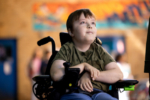Top 10 SMA Stories of 2021

SMA News Today brought you daily coverage of the latest scientific findings, treatment developments, and clinical trials related to spinal muscular atrophy (SMA) throughout 2021.
As a reminder of what mattered most to you during this year, here are the top 10 most-read articles of 2021 with a brief description of what made them interesting and relevant to the SMA community.
We look forward to reporting more of this relevant news to patients, family members, and caregivers dealing with SMA during 2022.
No. 10 – “SMA Doesn’t Stop Teen From Pursuing Academic Dreams at MIT”
In an October phone interview with SMA News Today, Ben Lou, who has SMA type 2, and his mother Jenny Huang shared the inspirational journey leading to his acceptance at his dream school, the world-renowned Massachusetts Institute of Technology (MIT). Despite being completely reliant on the help of others — namely, his mother — since he was 6 months old, Lou, a San Diego native, did not let SMA get in the way of pursuing his dream of becoming a mathematician, an academic researcher, and an entrepreneur.
“You have two choices,” Lou said. “You can sulk and be depressed, which is the easy thing,” or you can “stay positive and look for the best solution.”
His love for learning and relentless positive attitude, combined with his mother’s efforts to educate him “everywhere and at every moment,” as Huang said, resulted in several notable academic successes before his MIT acceptance. Now, Lou hopes to join undergraduate research projects and work on his own inventions aiming to help others with disabilities.
No. 9 – “Danish Family Races to Raise $2.4M for Daughter’s Zolgensma Therapy”
In April, we covered the story of a Danish family racing against time to raise the $2.4 million needed to treat their 15-month-old daughter, Ayah Lundt, with a single dose of Zolgensma in the U.S. before she turned 2 and became ineligible for the treatment in that country.
Novartis’ one-time gene therapy is conditionally approved in Europe for certain children with SMA, but it has not received public reimbursement in Denmark. While Ayah was being treated with Spinraza (nusinersen) — the first disease-modifying therapy (DMT), by Biogen, approved for SMA — her condition did not seem to improve, only 5o stabilize. At the time of publication, Ayah’s parents, along with a team of volunteers, had raised about $1.5 million, and still needed nearly $1 million to reach their goal.
No. 8 — “#MDA2021 – Zolgensma Continues to Prevent Motor Function Decline for 5 Years”
Data from Zolgensma’s trials in young children with SMA and two long-term extension studies —LT-001 (NCT03421977) and LT-002 (NCT04042025) — showed that a single dose of the gene therapy was generally safe and effectively prevented motor function decline for at least five years.
Notably, treated children with type 1 disease, a severe form, achieved and maintained several developmental milestones rarely or never attained by those left untreated. These benefits were seen regardless of whether patients had subsequently received other SMA DMTs, such as Spinraza or Genentech’s Evrysdi. Results also highlighted that “the younger the patients are, the better they do … [and] the fewer side effects they have,” Jerry R. Mendell, MD, a principal investigator across Zolgensma’s clinical program, said in an oral presentation at the 2021 MDA Virtual Clinical and Scientific Conference, held in March.
No. 7 — “Motor Function, Breathing Important in Choosing Treatment”
A team of researchers in the U.S. reported that stabilizing or improving motor function and breathing are the factors that SMA patients and their caregivers value most when deciding on available treatments.
The Genentech-funded survey, involving 65 people with SMA and 36 caregivers, also showed that oral therapies were generally preferred, while those given through repeated injections into the spinal canal were the least favored. Therapy labels limited to children younger than 2 years old and treatments linked to serious or life-threatening safety risks were also mostly avoided.
No. 6 — “Zolgensma-Evrysdi Combo Likely Beneficial for SMA Type 1”
Researchers in the U.S. reported the cases of four children with SMA type 1 who started Evrysdi following a perceived plateau in therapeutic benefit with Zolgensma.
While both treatments work to restore the levels of the SMN protein, whose production is impaired in SMA patients, they do so through different mechanisms. Zolgensma uses a modified and harmless virus to deliver to cells a healthy copy of the SMN1 gene, which provides the instructions to produce SMN and is mutated in SMA. Evrysdi, a small molecule given orally once daily, targets SMN2, a backup gene that can partially compensate for the loss of SMN1-derived SMN.
Results showed that initiating Evrysdi after Zolgensma was generally safe and resulted in motor function improvements in all children within one month of daily treatment. Three children gained motor skills that are rarely seen in untreated type 1 patients.
No. 5 — “#AANAM – Zolgensma May Lead to Faster, Greater Gains Than Spinraza”
Results from a Novartis-funded online survey of 22 health providers in the U.S. suggested that Zolgensma may result in faster and greater functional improvements than Spinraza in infants with SMA treated up to 2 years of age. Unlike Zolgensma, Spinraza is given directly into the spinal canal every four months and is designed to increase SMN production by targeting the backup gene SMN2.
In the three previous years, these health providers had prescribed Zolgensma alone to 30 children with SMA, Spinraza alone to 54 patients, and Zolgensma after Spinraza to 19 children. While all treatment regimens resulted in functional improvements, a greater proportion of children given Zolgensma alone achieved gains in all evaluated domains. These gains were also detected two to nearly four months earlier than with the other two regimens.
No. 4 — “Muscle-directed Therapy Apitegromab Put on FDA’s Fast Track”
The U.S. Food and Drug Administration granted fast track designation to apitegromab, Scholar Rock’s muscle-directed therapy for SMA, in May. The therapy previously received orphan drug designation in the U.S. and Europe, as well as rare pediatric disease status in the U.S. and priority medicines designation in Europe. These designations are meant to expedite apitegromab’s clinical development and regulatory review.
Administered directly into the bloodstream every four weeks, the therapy is designed to increase muscle strength and function by selectively preventing the generation of the active form of myostatin, a protein that suppresses muscle growth. As a muscle-directed therapy, its mechanism of action is distinct from currently approved disease modifying therapies for SMA, all of which working by increasing SMN levels.
A global Phase 3 trial, called SAPPHIRE (NCT05156320), will test apitegromab as an add-on therapy to either Spinraza or Evrysdi in up to 204 children and young adults with SMA type 2 or 3 who are unable to walk. The study is not yet enrolling, more information on contacts and locations can be found here.
No. 3 — “Higher-dose Spinraza Trial Now Enrolling Part B After No Safety Issues Found”
In January, Biogen announced that its global Phase 2/3 DEVOTE trial (NCT04089566) testing higher doses of Spinraza in up to 172 SMA patients of all ages had moved into its efficacy-assessing Part B, after no safety concerns were identified during its Part A.
The study is currently enrolling children, ages 2 through 9, with types 1–3 to its Part B, in which they will be randomly assigned to receive either the approved 12 mg dose of Spinraza or a higher dose regimen. The latter includes two 50 mg loading doses 14 days apart, followed by 28 mg maintenance doses at about one, two, and six months.
In DEVOTE’s Part C, researchers will also evaluate whether it is safe to transition adult patients already on Spinraza to a higher dose regimen, consisting of an initial 50 mg dose followed by 28 mg maintenance doses four and eight months later.
No. 2 — “Novartis Stopping Work on Branaplam as Oral SMA Therapy”
Novartis announced in July that it was stopping the development of branaplam (LMI070) as a potential oral treatment for SMA. The decision was based on the rapid advancements in the SMA treatment landscape since 2016 and the fact that the therapy would no longer represent a highly differentiated option for SMA patients.
Similar to Spinraza and Evrysdi, branaplam targets the SMN2 gene. Since no safety or efficacy issues were detected up to that point, the company encouraged type 1 children enrolled in branaplam’s Phase 1/2 trial (NCT02268552) to continue treatment until an alternative was arranged.
Novartis planned to continue branaplam’s development as a potential therapy for Huntington’s disease, a rare, genetic neurodegenerative disease.
No. 1 — “A ‘Miracle’: Spinraza Gives Boy, Now 5, a Chance to Grow Up”
Our most-read article of 2021 concerned the story of 5-year-old Jase Yoder, who initiated Spinraza treatment in the Phase 2 NURTURE trial (NCT02386553) just 18 days after being diagnosed with SMA type 1.
Starting treatment when he was not yet 1 month old, Jase was featured as part of “The Gene” documentary on PBS last year and seen jumping on a trampoline — just one of the many motor abilities he would not have likely achieved without treatment. These normal life activities take on new meaning for his parents, who lost their first daughter, Ariel, to SMA when she was an infant.
“We started experiencing the delight that comes from just realizing he’s doing things that children with this diagnosis have never done before,” Cheryl Yoder, his mother, said in an interview with SMA News Today. “It truly is to us a miracle and you don’t want to lose the wonder of that.”
***
At SMA News Today, we hope these stories and our reporting throughout 2021 helped to better inform and improve the lives of everyone affected by SMA.
We wish all our readers a happy 2022.








